Report: Human Capital Management and Leadership at Marks & Spencer
VerifiedAdded on 2020/10/05
|17
|4926
|290
Report
AI Summary
This report provides a comprehensive analysis of human capital management and leadership within Marks and Spencer. It begins by defining human capital and leadership, then explores various HRM models such as the Harvard and Michigan models, detailing their application within the company. The report examines the recruitment and selection processes in relation to strategic human resource initiatives, outlining key stages and factors affecting the process. It also delves into different approaches to Human Resource Development (HRD), offering recommendations for improvement. Furthermore, the report investigates classical theories of motivation, including Hybrid theory, and their practical value within Marks and Spencer. Finally, it discusses the characteristics of effective leaders and different leadership styles. The report concludes by summarizing the key findings and offering insights into the effective management of human capital and leadership within the organization.
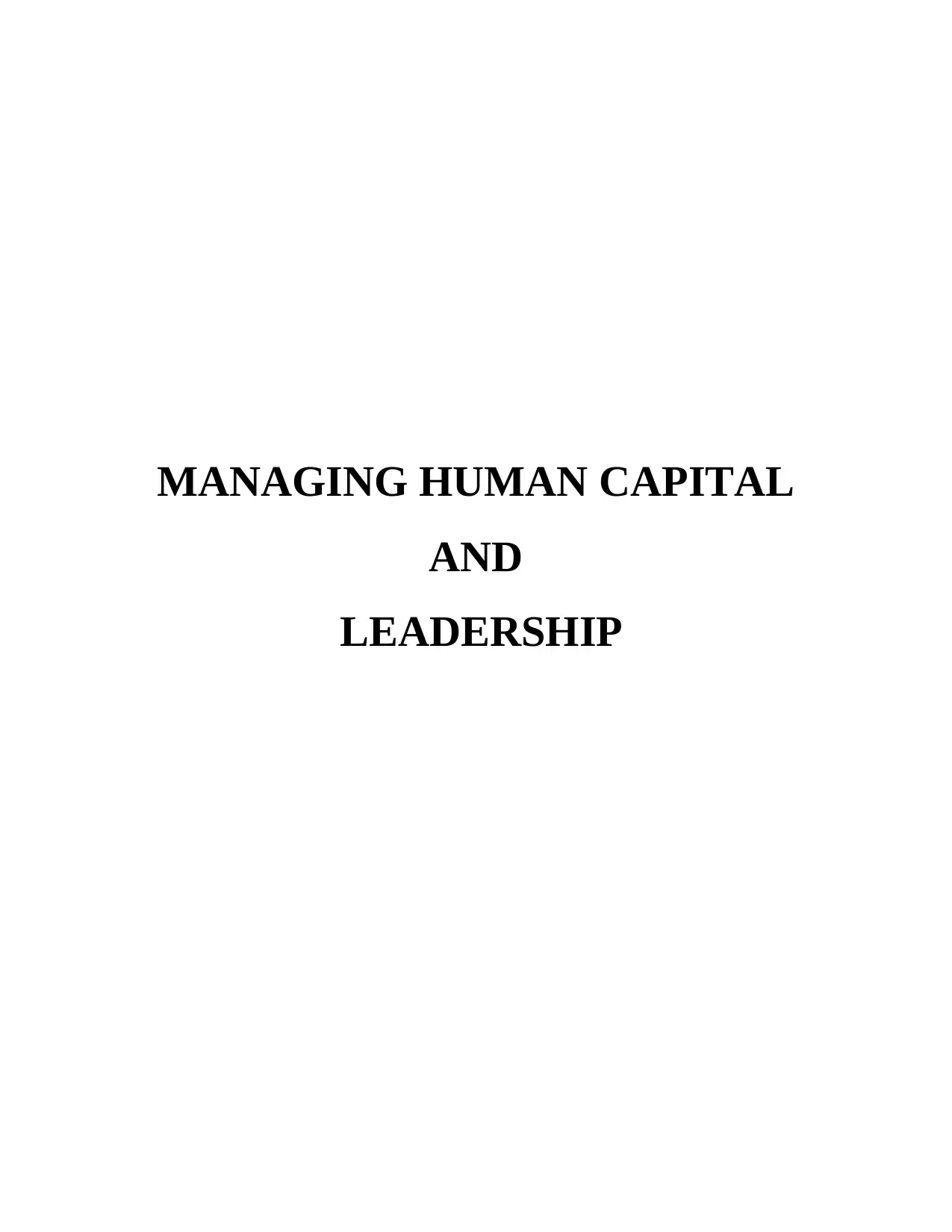
MANAGING HUMAN CAPITAL
AND
LEADERSHIP
AND
LEADERSHIP
Paraphrase This Document
Need a fresh take? Get an instant paraphrase of this document with our AI Paraphraser
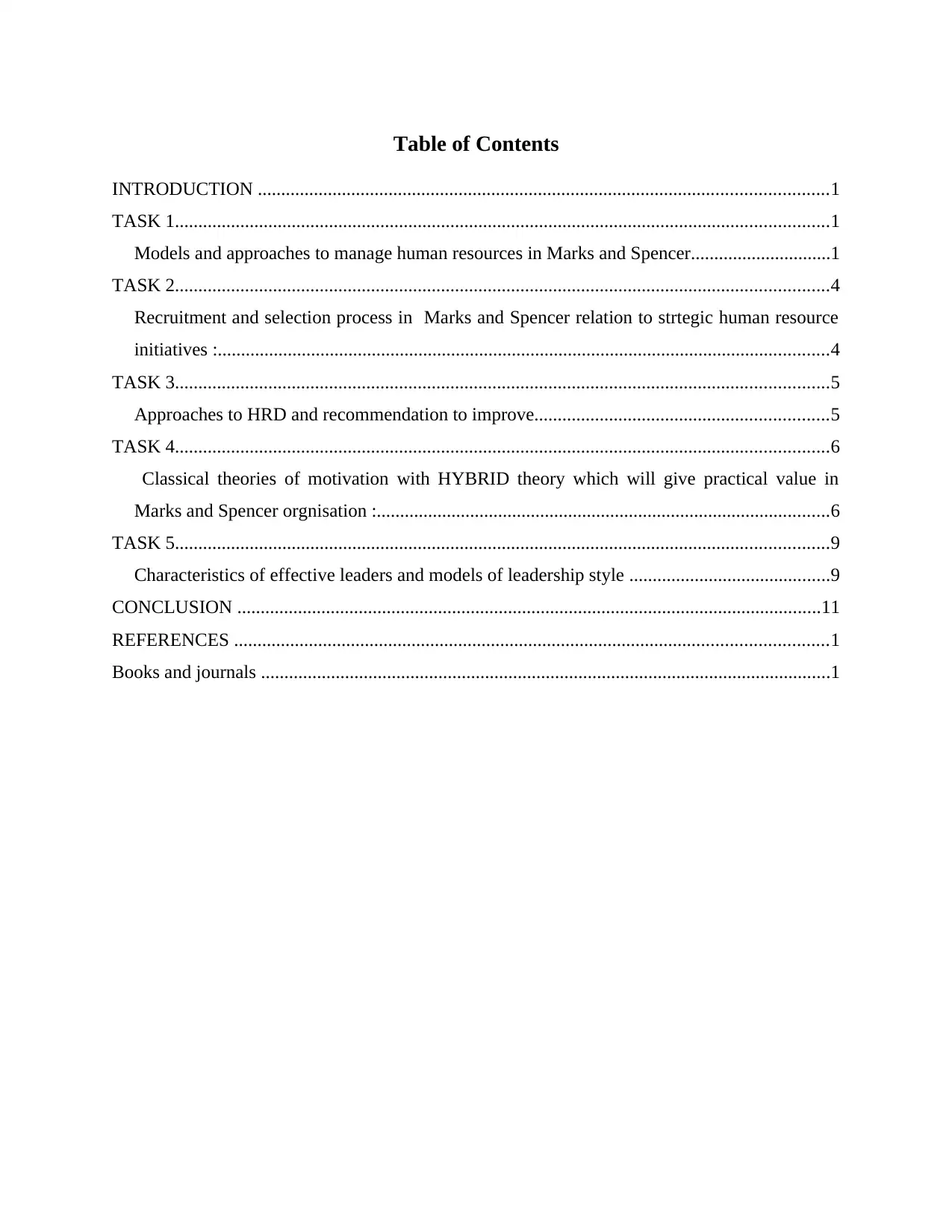
Table of Contents
INTRODUCTION ..........................................................................................................................1
TASK 1............................................................................................................................................1
Models and approaches to manage human resources in Marks and Spencer..............................1
TASK 2............................................................................................................................................4
Recruitment and selection process in Marks and Spencer relation to strtegic human resource
initiatives :...................................................................................................................................4
TASK 3............................................................................................................................................5
Approaches to HRD and recommendation to improve...............................................................5
TASK 4............................................................................................................................................6
Classical theories of motivation with HYBRID theory which will give practical value in
Marks and Spencer orgnisation :.................................................................................................6
TASK 5............................................................................................................................................9
Characteristics of effective leaders and models of leadership style ...........................................9
CONCLUSION .............................................................................................................................11
REFERENCES ...............................................................................................................................1
Books and journals ..........................................................................................................................1
INTRODUCTION ..........................................................................................................................1
TASK 1............................................................................................................................................1
Models and approaches to manage human resources in Marks and Spencer..............................1
TASK 2............................................................................................................................................4
Recruitment and selection process in Marks and Spencer relation to strtegic human resource
initiatives :...................................................................................................................................4
TASK 3............................................................................................................................................5
Approaches to HRD and recommendation to improve...............................................................5
TASK 4............................................................................................................................................6
Classical theories of motivation with HYBRID theory which will give practical value in
Marks and Spencer orgnisation :.................................................................................................6
TASK 5............................................................................................................................................9
Characteristics of effective leaders and models of leadership style ...........................................9
CONCLUSION .............................................................................................................................11
REFERENCES ...............................................................................................................................1
Books and journals ..........................................................................................................................1
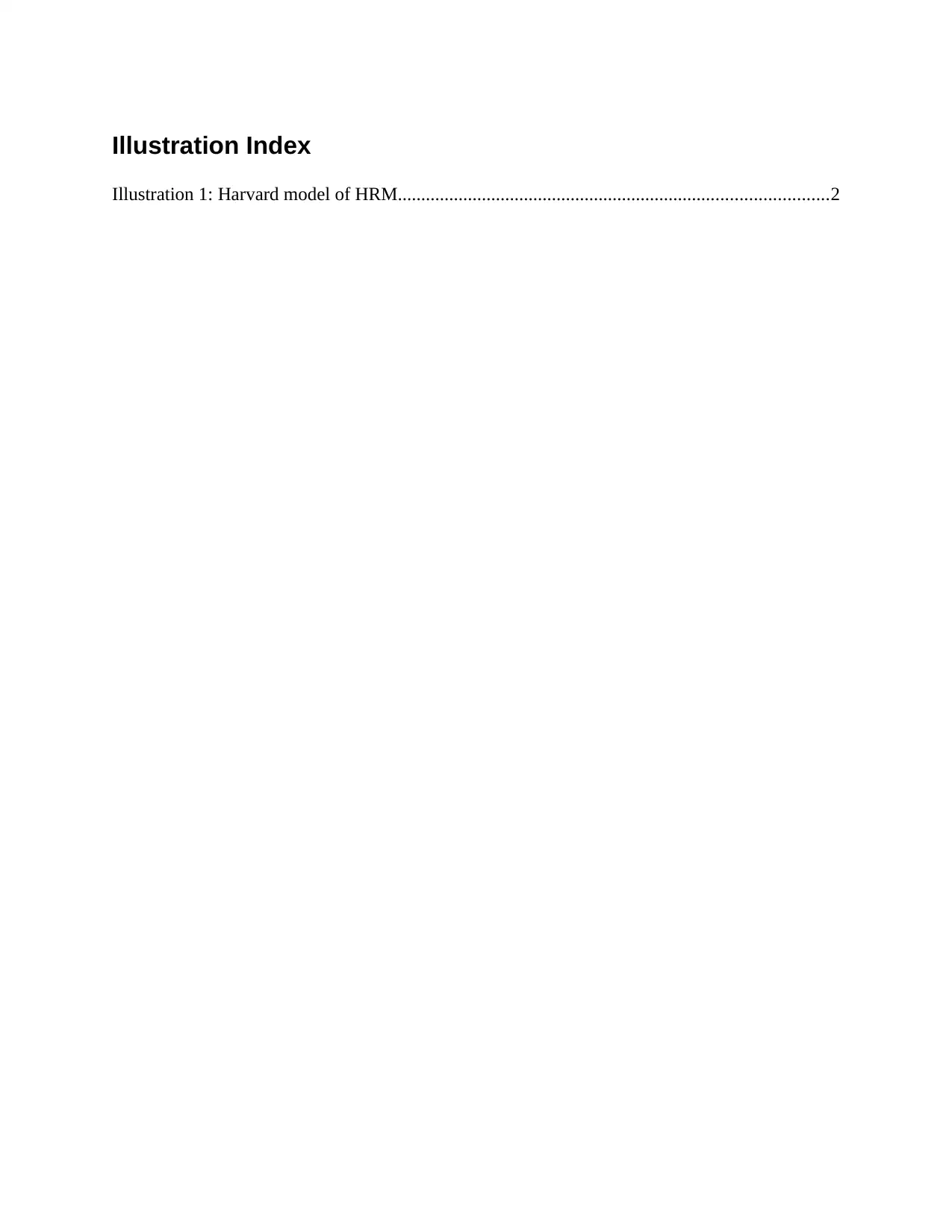
Illustration Index
Illustration 1: Harvard model of HRM............................................................................................2
Illustration 1: Harvard model of HRM............................................................................................2
⊘ This is a preview!⊘
Do you want full access?
Subscribe today to unlock all pages.

Trusted by 1+ million students worldwide
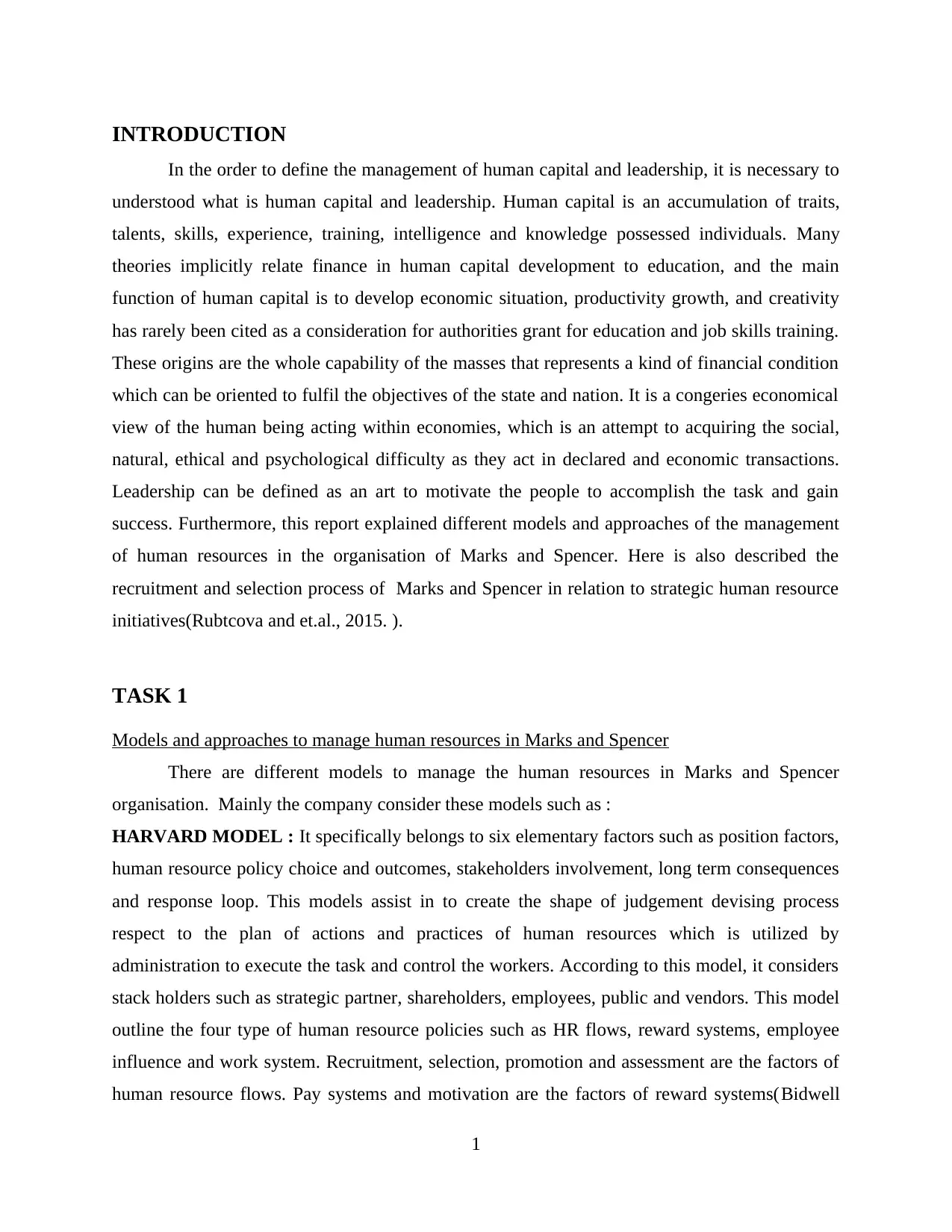
INTRODUCTION
In the order to define the management of human capital and leadership, it is necessary to
understood what is human capital and leadership. Human capital is an accumulation of traits,
talents, skills, experience, training, intelligence and knowledge possessed individuals. Many
theories implicitly relate finance in human capital development to education, and the main
function of human capital is to develop economic situation, productivity growth, and creativity
has rarely been cited as a consideration for authorities grant for education and job skills training.
These origins are the whole capability of the masses that represents a kind of financial condition
which can be oriented to fulfil the objectives of the state and nation. It is a congeries economical
view of the human being acting within economies, which is an attempt to acquiring the social,
natural, ethical and psychological difficulty as they act in declared and economic transactions.
Leadership can be defined as an art to motivate the people to accomplish the task and gain
success. Furthermore, this report explained different models and approaches of the management
of human resources in the organisation of Marks and Spencer. Here is also described the
recruitment and selection process of Marks and Spencer in relation to strategic human resource
initiatives(Rubtcova and et.al., 2015. ).
TASK 1
Models and approaches to manage human resources in Marks and Spencer
There are different models to manage the human resources in Marks and Spencer
organisation. Mainly the company consider these models such as :
HARVARD MODEL : It specifically belongs to six elementary factors such as position factors,
human resource policy choice and outcomes, stakeholders involvement, long term consequences
and response loop. This models assist in to create the shape of judgement devising process
respect to the plan of actions and practices of human resources which is utilized by
administration to execute the task and control the workers. According to this model, it considers
stack holders such as strategic partner, shareholders, employees, public and vendors. This model
outline the four type of human resource policies such as HR flows, reward systems, employee
influence and work system. Recruitment, selection, promotion and assessment are the factors of
human resource flows. Pay systems and motivation are the factors of reward systems(Bidwell
1
In the order to define the management of human capital and leadership, it is necessary to
understood what is human capital and leadership. Human capital is an accumulation of traits,
talents, skills, experience, training, intelligence and knowledge possessed individuals. Many
theories implicitly relate finance in human capital development to education, and the main
function of human capital is to develop economic situation, productivity growth, and creativity
has rarely been cited as a consideration for authorities grant for education and job skills training.
These origins are the whole capability of the masses that represents a kind of financial condition
which can be oriented to fulfil the objectives of the state and nation. It is a congeries economical
view of the human being acting within economies, which is an attempt to acquiring the social,
natural, ethical and psychological difficulty as they act in declared and economic transactions.
Leadership can be defined as an art to motivate the people to accomplish the task and gain
success. Furthermore, this report explained different models and approaches of the management
of human resources in the organisation of Marks and Spencer. Here is also described the
recruitment and selection process of Marks and Spencer in relation to strategic human resource
initiatives(Rubtcova and et.al., 2015. ).
TASK 1
Models and approaches to manage human resources in Marks and Spencer
There are different models to manage the human resources in Marks and Spencer
organisation. Mainly the company consider these models such as :
HARVARD MODEL : It specifically belongs to six elementary factors such as position factors,
human resource policy choice and outcomes, stakeholders involvement, long term consequences
and response loop. This models assist in to create the shape of judgement devising process
respect to the plan of actions and practices of human resources which is utilized by
administration to execute the task and control the workers. According to this model, it considers
stack holders such as strategic partner, shareholders, employees, public and vendors. This model
outline the four type of human resource policies such as HR flows, reward systems, employee
influence and work system. Recruitment, selection, promotion and assessment are the factors of
human resource flows. Pay systems and motivation are the factors of reward systems(Bidwell
1
Paraphrase This Document
Need a fresh take? Get an instant paraphrase of this document with our AI Paraphraser
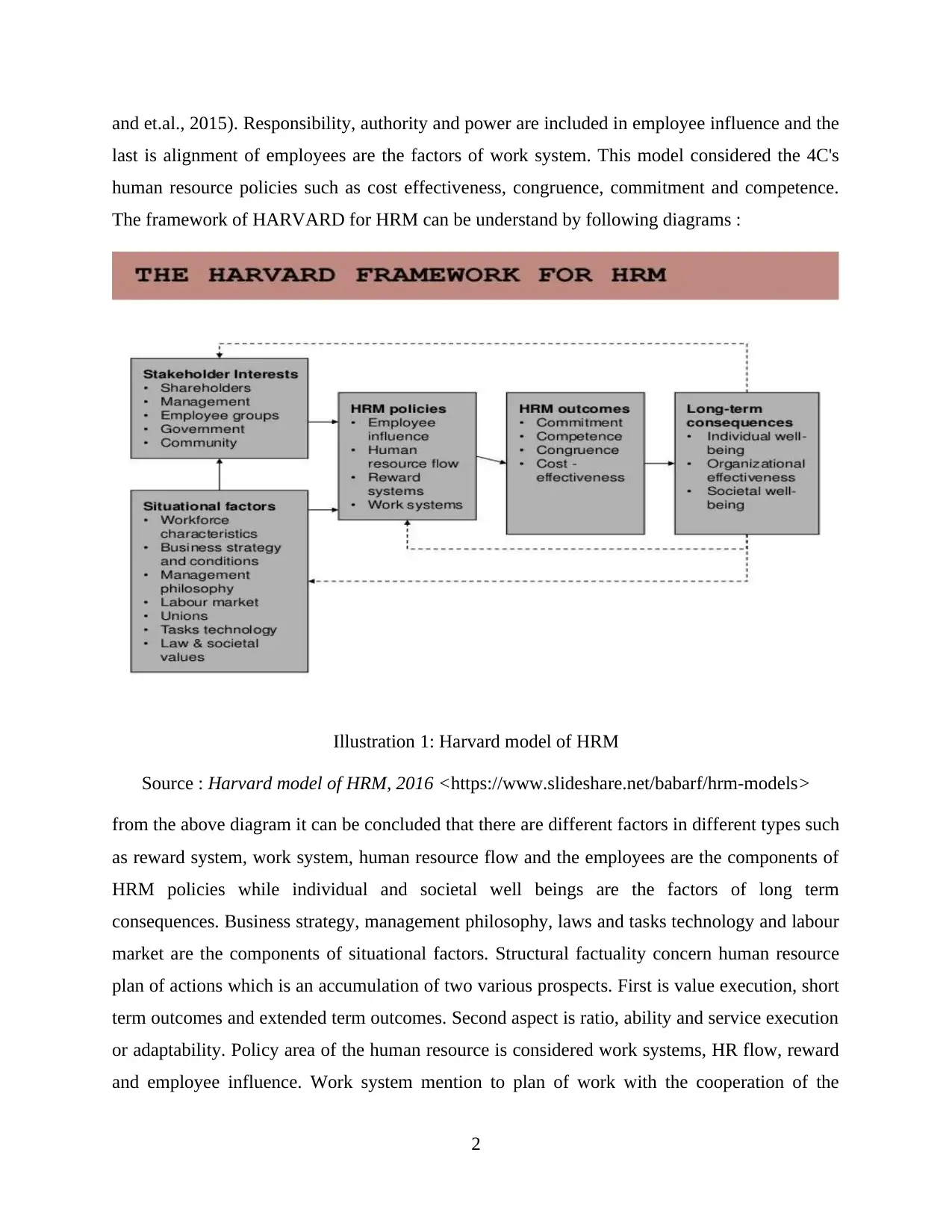
and et.al., 2015). Responsibility, authority and power are included in employee influence and the
last is alignment of employees are the factors of work system. This model considered the 4C's
human resource policies such as cost effectiveness, congruence, commitment and competence.
The framework of HARVARD for HRM can be understand by following diagrams :
Illustration 1: Harvard model of HRM
Source : Harvard model of HRM, 2016 <https://www.slideshare.net/babarf/hrm-models>
from the above diagram it can be concluded that there are different factors in different types such
as reward system, work system, human resource flow and the employees are the components of
HRM policies while individual and societal well beings are the factors of long term
consequences. Business strategy, management philosophy, laws and tasks technology and labour
market are the components of situational factors. Structural factuality concern human resource
plan of actions which is an accumulation of two various prospects. First is value execution, short
term outcomes and extended term outcomes. Second aspect is ratio, ability and service execution
or adaptability. Policy area of the human resource is considered work systems, HR flow, reward
and employee influence. Work system mention to plan of work with the cooperation of the
2
last is alignment of employees are the factors of work system. This model considered the 4C's
human resource policies such as cost effectiveness, congruence, commitment and competence.
The framework of HARVARD for HRM can be understand by following diagrams :
Illustration 1: Harvard model of HRM
Source : Harvard model of HRM, 2016 <https://www.slideshare.net/babarf/hrm-models>
from the above diagram it can be concluded that there are different factors in different types such
as reward system, work system, human resource flow and the employees are the components of
HRM policies while individual and societal well beings are the factors of long term
consequences. Business strategy, management philosophy, laws and tasks technology and labour
market are the components of situational factors. Structural factuality concern human resource
plan of actions which is an accumulation of two various prospects. First is value execution, short
term outcomes and extended term outcomes. Second aspect is ratio, ability and service execution
or adaptability. Policy area of the human resource is considered work systems, HR flow, reward
and employee influence. Work system mention to plan of work with the cooperation of the
2
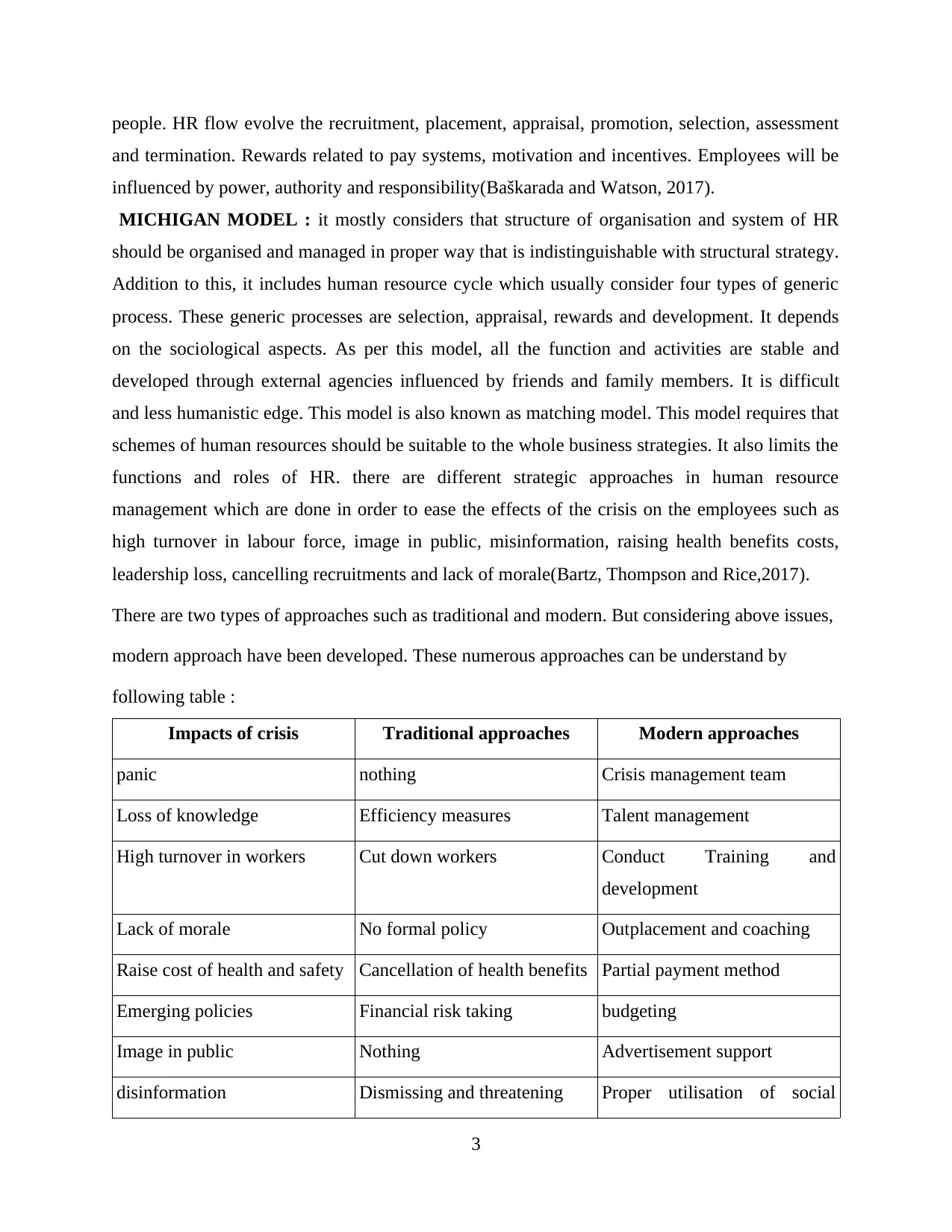
people. HR flow evolve the recruitment, placement, appraisal, promotion, selection, assessment
and termination. Rewards related to pay systems, motivation and incentives. Employees will be
influenced by power, authority and responsibility(Baškarada and Watson, 2017).
MICHIGAN MODEL : it mostly considers that structure of organisation and system of HR
should be organised and managed in proper way that is indistinguishable with structural strategy.
Addition to this, it includes human resource cycle which usually consider four types of generic
process. These generic processes are selection, appraisal, rewards and development. It depends
on the sociological aspects. As per this model, all the function and activities are stable and
developed through external agencies influenced by friends and family members. It is difficult
and less humanistic edge. This model is also known as matching model. This model requires that
schemes of human resources should be suitable to the whole business strategies. It also limits the
functions and roles of HR. there are different strategic approaches in human resource
management which are done in order to ease the effects of the crisis on the employees such as
high turnover in labour force, image in public, misinformation, raising health benefits costs,
leadership loss, cancelling recruitments and lack of morale(Bartz, Thompson and Rice,2017).
There are two types of approaches such as traditional and modern. But considering above issues,
modern approach have been developed. These numerous approaches can be understand by
following table :
Impacts of crisis Traditional approaches Modern approaches
panic nothing Crisis management team
Loss of knowledge Efficiency measures Talent management
High turnover in workers Cut down workers Conduct Training and
development
Lack of morale No formal policy Outplacement and coaching
Raise cost of health and safety Cancellation of health benefits Partial payment method
Emerging policies Financial risk taking budgeting
Image in public Nothing Advertisement support
disinformation Dismissing and threatening Proper utilisation of social
3
and termination. Rewards related to pay systems, motivation and incentives. Employees will be
influenced by power, authority and responsibility(Baškarada and Watson, 2017).
MICHIGAN MODEL : it mostly considers that structure of organisation and system of HR
should be organised and managed in proper way that is indistinguishable with structural strategy.
Addition to this, it includes human resource cycle which usually consider four types of generic
process. These generic processes are selection, appraisal, rewards and development. It depends
on the sociological aspects. As per this model, all the function and activities are stable and
developed through external agencies influenced by friends and family members. It is difficult
and less humanistic edge. This model is also known as matching model. This model requires that
schemes of human resources should be suitable to the whole business strategies. It also limits the
functions and roles of HR. there are different strategic approaches in human resource
management which are done in order to ease the effects of the crisis on the employees such as
high turnover in labour force, image in public, misinformation, raising health benefits costs,
leadership loss, cancelling recruitments and lack of morale(Bartz, Thompson and Rice,2017).
There are two types of approaches such as traditional and modern. But considering above issues,
modern approach have been developed. These numerous approaches can be understand by
following table :
Impacts of crisis Traditional approaches Modern approaches
panic nothing Crisis management team
Loss of knowledge Efficiency measures Talent management
High turnover in workers Cut down workers Conduct Training and
development
Lack of morale No formal policy Outplacement and coaching
Raise cost of health and safety Cancellation of health benefits Partial payment method
Emerging policies Financial risk taking budgeting
Image in public Nothing Advertisement support
disinformation Dismissing and threatening Proper utilisation of social
3
⊘ This is a preview!⊘
Do you want full access?
Subscribe today to unlock all pages.

Trusted by 1+ million students worldwide
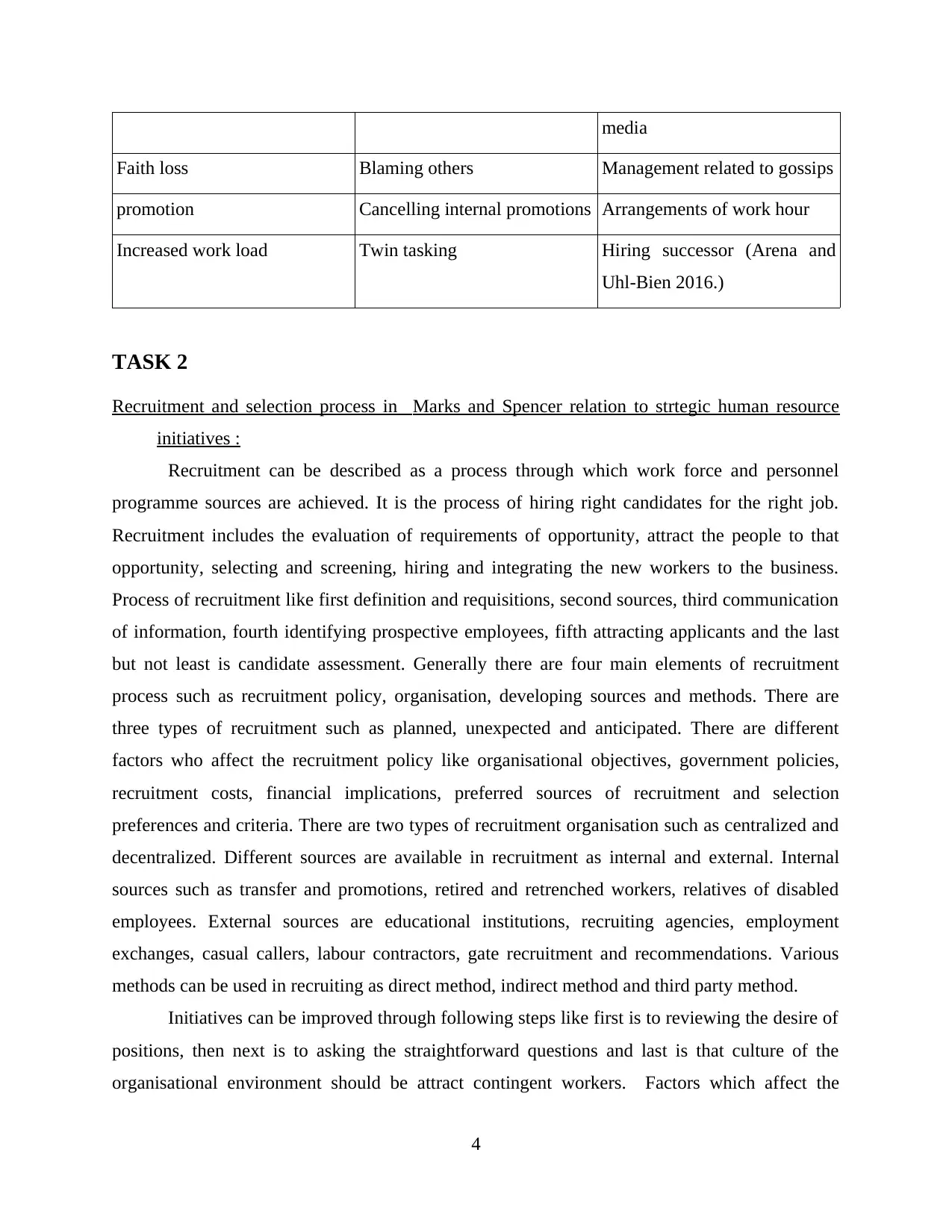
media
Faith loss Blaming others Management related to gossips
promotion Cancelling internal promotions Arrangements of work hour
Increased work load Twin tasking Hiring successor (Arena and
Uhl-Bien 2016.)
TASK 2
Recruitment and selection process in Marks and Spencer relation to strtegic human resource
initiatives :
Recruitment can be described as a process through which work force and personnel
programme sources are achieved. It is the process of hiring right candidates for the right job.
Recruitment includes the evaluation of requirements of opportunity, attract the people to that
opportunity, selecting and screening, hiring and integrating the new workers to the business.
Process of recruitment like first definition and requisitions, second sources, third communication
of information, fourth identifying prospective employees, fifth attracting applicants and the last
but not least is candidate assessment. Generally there are four main elements of recruitment
process such as recruitment policy, organisation, developing sources and methods. There are
three types of recruitment such as planned, unexpected and anticipated. There are different
factors who affect the recruitment policy like organisational objectives, government policies,
recruitment costs, financial implications, preferred sources of recruitment and selection
preferences and criteria. There are two types of recruitment organisation such as centralized and
decentralized. Different sources are available in recruitment as internal and external. Internal
sources such as transfer and promotions, retired and retrenched workers, relatives of disabled
employees. External sources are educational institutions, recruiting agencies, employment
exchanges, casual callers, labour contractors, gate recruitment and recommendations. Various
methods can be used in recruiting as direct method, indirect method and third party method.
Initiatives can be improved through following steps like first is to reviewing the desire of
positions, then next is to asking the straightforward questions and last is that culture of the
organisational environment should be attract contingent workers. Factors which affect the
4
Faith loss Blaming others Management related to gossips
promotion Cancelling internal promotions Arrangements of work hour
Increased work load Twin tasking Hiring successor (Arena and
Uhl-Bien 2016.)
TASK 2
Recruitment and selection process in Marks and Spencer relation to strtegic human resource
initiatives :
Recruitment can be described as a process through which work force and personnel
programme sources are achieved. It is the process of hiring right candidates for the right job.
Recruitment includes the evaluation of requirements of opportunity, attract the people to that
opportunity, selecting and screening, hiring and integrating the new workers to the business.
Process of recruitment like first definition and requisitions, second sources, third communication
of information, fourth identifying prospective employees, fifth attracting applicants and the last
but not least is candidate assessment. Generally there are four main elements of recruitment
process such as recruitment policy, organisation, developing sources and methods. There are
three types of recruitment such as planned, unexpected and anticipated. There are different
factors who affect the recruitment policy like organisational objectives, government policies,
recruitment costs, financial implications, preferred sources of recruitment and selection
preferences and criteria. There are two types of recruitment organisation such as centralized and
decentralized. Different sources are available in recruitment as internal and external. Internal
sources such as transfer and promotions, retired and retrenched workers, relatives of disabled
employees. External sources are educational institutions, recruiting agencies, employment
exchanges, casual callers, labour contractors, gate recruitment and recommendations. Various
methods can be used in recruiting as direct method, indirect method and third party method.
Initiatives can be improved through following steps like first is to reviewing the desire of
positions, then next is to asking the straightforward questions and last is that culture of the
organisational environment should be attract contingent workers. Factors which affect the
4
Paraphrase This Document
Need a fresh take? Get an instant paraphrase of this document with our AI Paraphraser
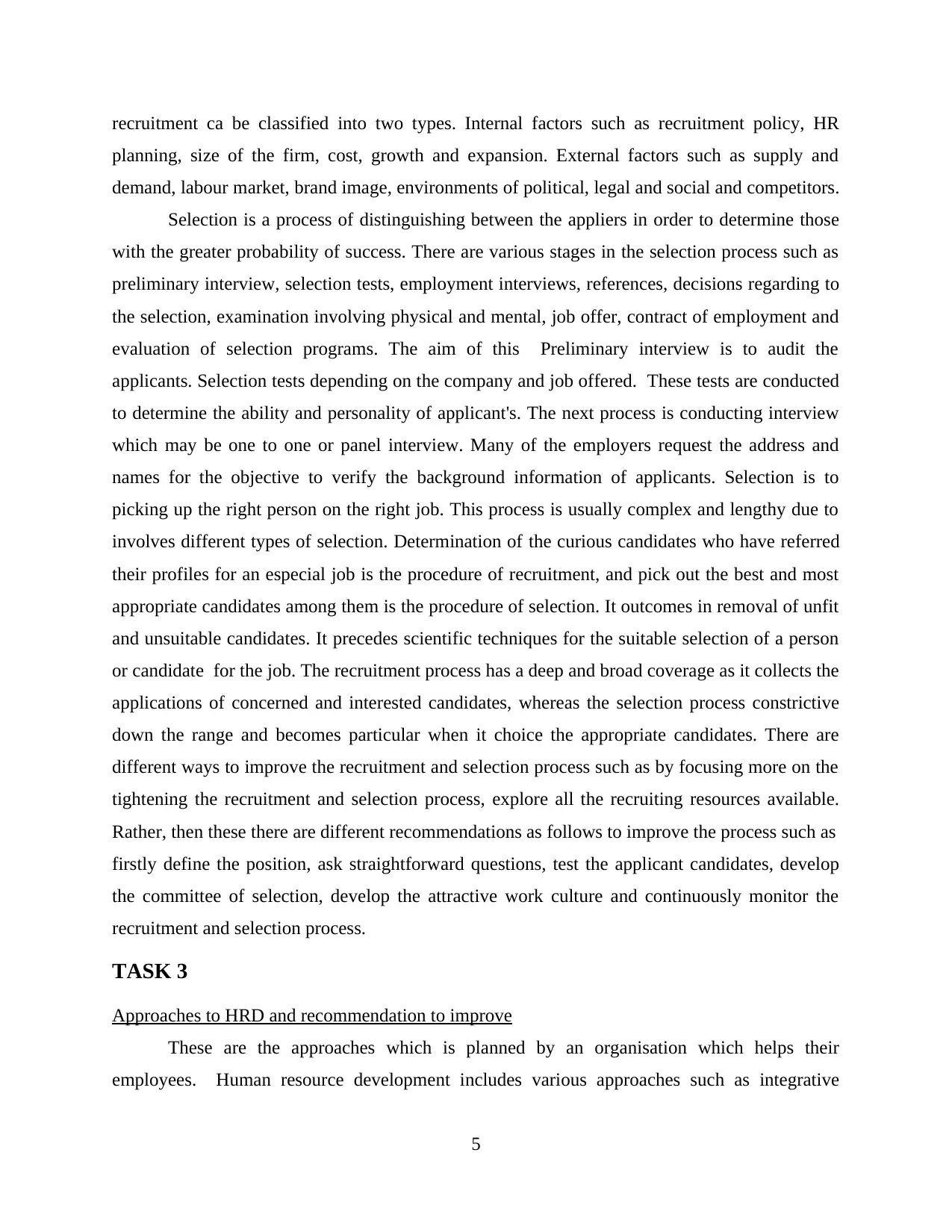
recruitment ca be classified into two types. Internal factors such as recruitment policy, HR
planning, size of the firm, cost, growth and expansion. External factors such as supply and
demand, labour market, brand image, environments of political, legal and social and competitors.
Selection is a process of distinguishing between the appliers in order to determine those
with the greater probability of success. There are various stages in the selection process such as
preliminary interview, selection tests, employment interviews, references, decisions regarding to
the selection, examination involving physical and mental, job offer, contract of employment and
evaluation of selection programs. The aim of this Preliminary interview is to audit the
applicants. Selection tests depending on the company and job offered. These tests are conducted
to determine the ability and personality of applicant's. The next process is conducting interview
which may be one to one or panel interview. Many of the employers request the address and
names for the objective to verify the background information of applicants. Selection is to
picking up the right person on the right job. This process is usually complex and lengthy due to
involves different types of selection. Determination of the curious candidates who have referred
their profiles for an especial job is the procedure of recruitment, and pick out the best and most
appropriate candidates among them is the procedure of selection. It outcomes in removal of unfit
and unsuitable candidates. It precedes scientific techniques for the suitable selection of a person
or candidate for the job. The recruitment process has a deep and broad coverage as it collects the
applications of concerned and interested candidates, whereas the selection process constrictive
down the range and becomes particular when it choice the appropriate candidates. There are
different ways to improve the recruitment and selection process such as by focusing more on the
tightening the recruitment and selection process, explore all the recruiting resources available.
Rather, then these there are different recommendations as follows to improve the process such as
firstly define the position, ask straightforward questions, test the applicant candidates, develop
the committee of selection, develop the attractive work culture and continuously monitor the
recruitment and selection process.
TASK 3
Approaches to HRD and recommendation to improve
These are the approaches which is planned by an organisation which helps their
employees. Human resource development includes various approaches such as integrative
5
planning, size of the firm, cost, growth and expansion. External factors such as supply and
demand, labour market, brand image, environments of political, legal and social and competitors.
Selection is a process of distinguishing between the appliers in order to determine those
with the greater probability of success. There are various stages in the selection process such as
preliminary interview, selection tests, employment interviews, references, decisions regarding to
the selection, examination involving physical and mental, job offer, contract of employment and
evaluation of selection programs. The aim of this Preliminary interview is to audit the
applicants. Selection tests depending on the company and job offered. These tests are conducted
to determine the ability and personality of applicant's. The next process is conducting interview
which may be one to one or panel interview. Many of the employers request the address and
names for the objective to verify the background information of applicants. Selection is to
picking up the right person on the right job. This process is usually complex and lengthy due to
involves different types of selection. Determination of the curious candidates who have referred
their profiles for an especial job is the procedure of recruitment, and pick out the best and most
appropriate candidates among them is the procedure of selection. It outcomes in removal of unfit
and unsuitable candidates. It precedes scientific techniques for the suitable selection of a person
or candidate for the job. The recruitment process has a deep and broad coverage as it collects the
applications of concerned and interested candidates, whereas the selection process constrictive
down the range and becomes particular when it choice the appropriate candidates. There are
different ways to improve the recruitment and selection process such as by focusing more on the
tightening the recruitment and selection process, explore all the recruiting resources available.
Rather, then these there are different recommendations as follows to improve the process such as
firstly define the position, ask straightforward questions, test the applicant candidates, develop
the committee of selection, develop the attractive work culture and continuously monitor the
recruitment and selection process.
TASK 3
Approaches to HRD and recommendation to improve
These are the approaches which is planned by an organisation which helps their
employees. Human resource development includes various approaches such as integrative
5
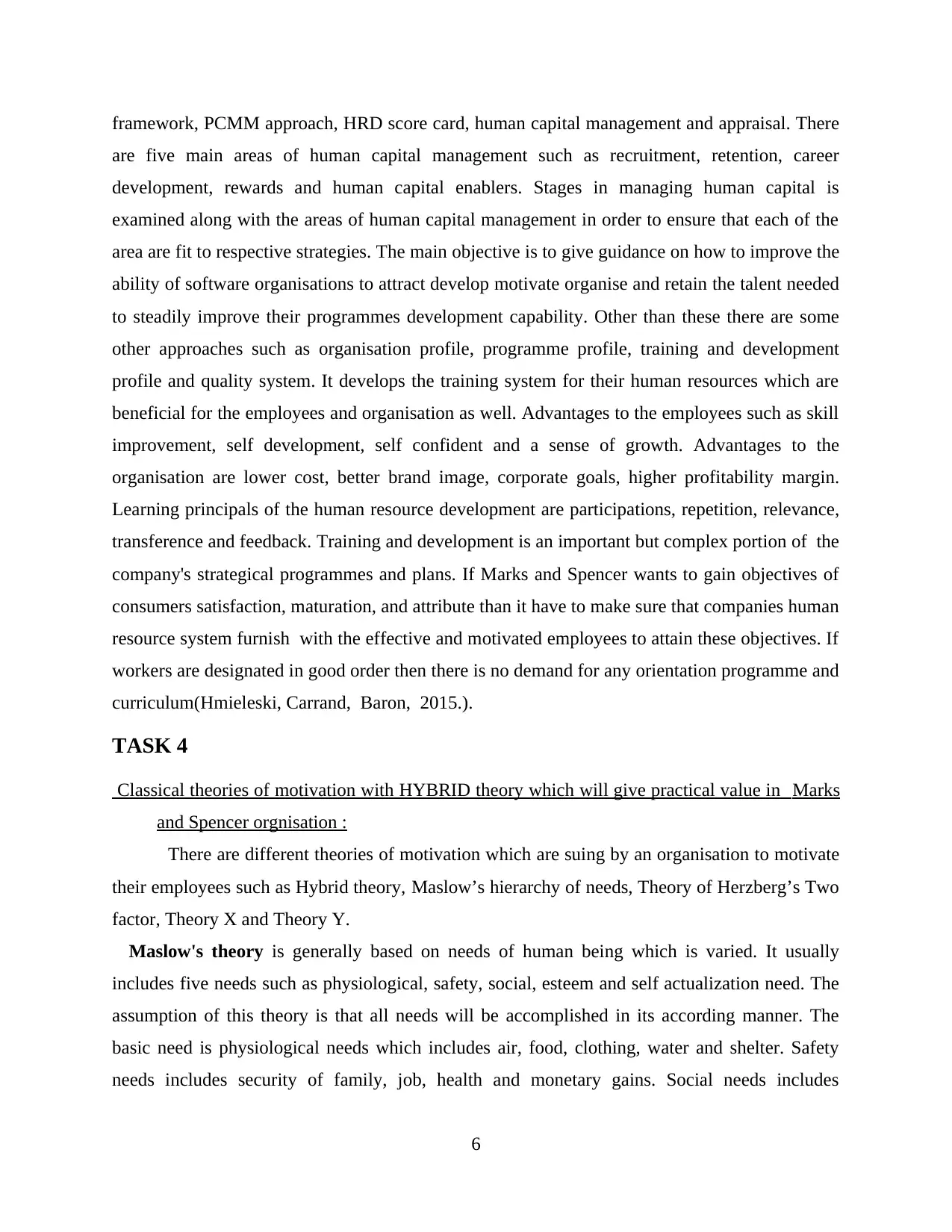
framework, PCMM approach, HRD score card, human capital management and appraisal. There
are five main areas of human capital management such as recruitment, retention, career
development, rewards and human capital enablers. Stages in managing human capital is
examined along with the areas of human capital management in order to ensure that each of the
area are fit to respective strategies. The main objective is to give guidance on how to improve the
ability of software organisations to attract develop motivate organise and retain the talent needed
to steadily improve their programmes development capability. Other than these there are some
other approaches such as organisation profile, programme profile, training and development
profile and quality system. It develops the training system for their human resources which are
beneficial for the employees and organisation as well. Advantages to the employees such as skill
improvement, self development, self confident and a sense of growth. Advantages to the
organisation are lower cost, better brand image, corporate goals, higher profitability margin.
Learning principals of the human resource development are participations, repetition, relevance,
transference and feedback. Training and development is an important but complex portion of the
company's strategical programmes and plans. If Marks and Spencer wants to gain objectives of
consumers satisfaction, maturation, and attribute than it have to make sure that companies human
resource system furnish with the effective and motivated employees to attain these objectives. If
workers are designated in good order then there is no demand for any orientation programme and
curriculum(Hmieleski, Carrand, Baron, 2015.).
TASK 4
Classical theories of motivation with HYBRID theory which will give practical value in Marks
and Spencer orgnisation :
There are different theories of motivation which are suing by an organisation to motivate
their employees such as Hybrid theory, Maslow’s hierarchy of needs, Theory of Herzberg’s Two
factor, Theory X and Theory Y.
Maslow's theory is generally based on needs of human being which is varied. It usually
includes five needs such as physiological, safety, social, esteem and self actualization need. The
assumption of this theory is that all needs will be accomplished in its according manner. The
basic need is physiological needs which includes air, food, clothing, water and shelter. Safety
needs includes security of family, job, health and monetary gains. Social needs includes
6
are five main areas of human capital management such as recruitment, retention, career
development, rewards and human capital enablers. Stages in managing human capital is
examined along with the areas of human capital management in order to ensure that each of the
area are fit to respective strategies. The main objective is to give guidance on how to improve the
ability of software organisations to attract develop motivate organise and retain the talent needed
to steadily improve their programmes development capability. Other than these there are some
other approaches such as organisation profile, programme profile, training and development
profile and quality system. It develops the training system for their human resources which are
beneficial for the employees and organisation as well. Advantages to the employees such as skill
improvement, self development, self confident and a sense of growth. Advantages to the
organisation are lower cost, better brand image, corporate goals, higher profitability margin.
Learning principals of the human resource development are participations, repetition, relevance,
transference and feedback. Training and development is an important but complex portion of the
company's strategical programmes and plans. If Marks and Spencer wants to gain objectives of
consumers satisfaction, maturation, and attribute than it have to make sure that companies human
resource system furnish with the effective and motivated employees to attain these objectives. If
workers are designated in good order then there is no demand for any orientation programme and
curriculum(Hmieleski, Carrand, Baron, 2015.).
TASK 4
Classical theories of motivation with HYBRID theory which will give practical value in Marks
and Spencer orgnisation :
There are different theories of motivation which are suing by an organisation to motivate
their employees such as Hybrid theory, Maslow’s hierarchy of needs, Theory of Herzberg’s Two
factor, Theory X and Theory Y.
Maslow's theory is generally based on needs of human being which is varied. It usually
includes five needs such as physiological, safety, social, esteem and self actualization need. The
assumption of this theory is that all needs will be accomplished in its according manner. The
basic need is physiological needs which includes air, food, clothing, water and shelter. Safety
needs includes security of family, job, health and monetary gains. Social needs includes
6
⊘ This is a preview!⊘
Do you want full access?
Subscribe today to unlock all pages.

Trusted by 1+ million students worldwide
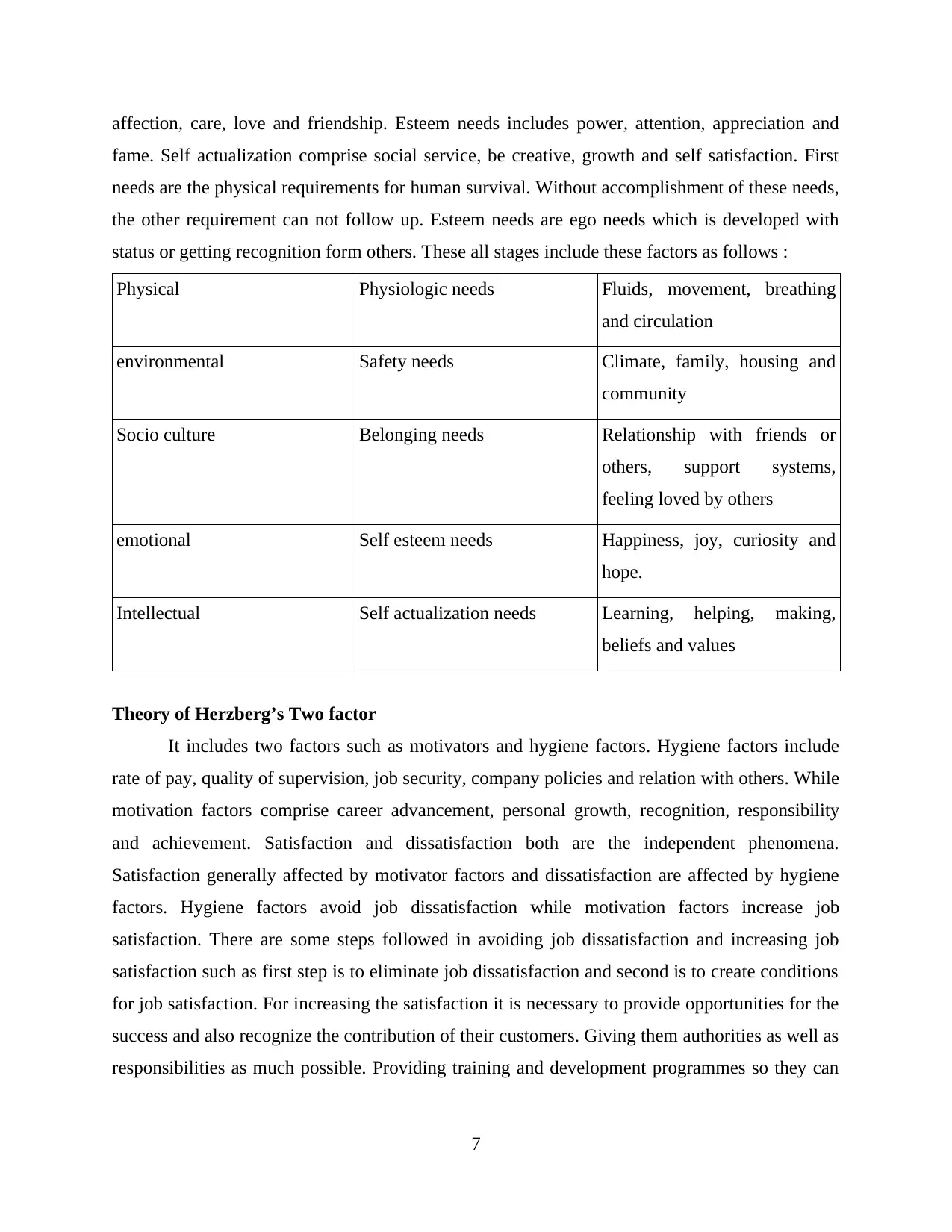
affection, care, love and friendship. Esteem needs includes power, attention, appreciation and
fame. Self actualization comprise social service, be creative, growth and self satisfaction. First
needs are the physical requirements for human survival. Without accomplishment of these needs,
the other requirement can not follow up. Esteem needs are ego needs which is developed with
status or getting recognition form others. These all stages include these factors as follows :
Physical Physiologic needs Fluids, movement, breathing
and circulation
environmental Safety needs Climate, family, housing and
community
Socio culture Belonging needs Relationship with friends or
others, support systems,
feeling loved by others
emotional Self esteem needs Happiness, joy, curiosity and
hope.
Intellectual Self actualization needs Learning, helping, making,
beliefs and values
Theory of Herzberg’s Two factor
It includes two factors such as motivators and hygiene factors. Hygiene factors include
rate of pay, quality of supervision, job security, company policies and relation with others. While
motivation factors comprise career advancement, personal growth, recognition, responsibility
and achievement. Satisfaction and dissatisfaction both are the independent phenomena.
Satisfaction generally affected by motivator factors and dissatisfaction are affected by hygiene
factors. Hygiene factors avoid job dissatisfaction while motivation factors increase job
satisfaction. There are some steps followed in avoiding job dissatisfaction and increasing job
satisfaction such as first step is to eliminate job dissatisfaction and second is to create conditions
for job satisfaction. For increasing the satisfaction it is necessary to provide opportunities for the
success and also recognize the contribution of their customers. Giving them authorities as well as
responsibilities as much possible. Providing training and development programmes so they can
7
fame. Self actualization comprise social service, be creative, growth and self satisfaction. First
needs are the physical requirements for human survival. Without accomplishment of these needs,
the other requirement can not follow up. Esteem needs are ego needs which is developed with
status or getting recognition form others. These all stages include these factors as follows :
Physical Physiologic needs Fluids, movement, breathing
and circulation
environmental Safety needs Climate, family, housing and
community
Socio culture Belonging needs Relationship with friends or
others, support systems,
feeling loved by others
emotional Self esteem needs Happiness, joy, curiosity and
hope.
Intellectual Self actualization needs Learning, helping, making,
beliefs and values
Theory of Herzberg’s Two factor
It includes two factors such as motivators and hygiene factors. Hygiene factors include
rate of pay, quality of supervision, job security, company policies and relation with others. While
motivation factors comprise career advancement, personal growth, recognition, responsibility
and achievement. Satisfaction and dissatisfaction both are the independent phenomena.
Satisfaction generally affected by motivator factors and dissatisfaction are affected by hygiene
factors. Hygiene factors avoid job dissatisfaction while motivation factors increase job
satisfaction. There are some steps followed in avoiding job dissatisfaction and increasing job
satisfaction such as first step is to eliminate job dissatisfaction and second is to create conditions
for job satisfaction. For increasing the satisfaction it is necessary to provide opportunities for the
success and also recognize the contribution of their customers. Giving them authorities as well as
responsibilities as much possible. Providing training and development programmes so they can
7
Paraphrase This Document
Need a fresh take? Get an instant paraphrase of this document with our AI Paraphraser
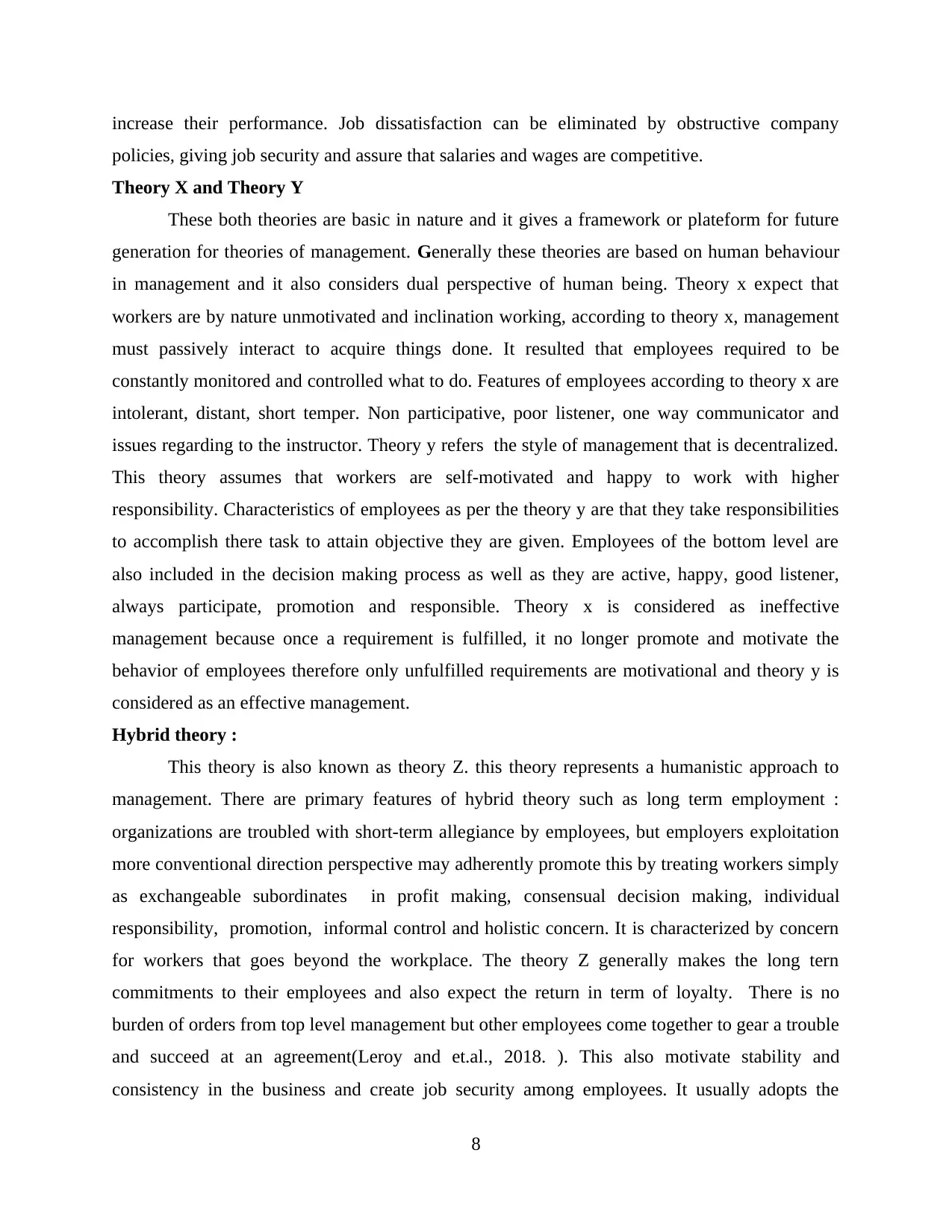
increase their performance. Job dissatisfaction can be eliminated by obstructive company
policies, giving job security and assure that salaries and wages are competitive.
Theory X and Theory Y
These both theories are basic in nature and it gives a framework or plateform for future
generation for theories of management. Generally these theories are based on human behaviour
in management and it also considers dual perspective of human being. Theory x expect that
workers are by nature unmotivated and inclination working, according to theory x, management
must passively interact to acquire things done. It resulted that employees required to be
constantly monitored and controlled what to do. Features of employees according to theory x are
intolerant, distant, short temper. Non participative, poor listener, one way communicator and
issues regarding to the instructor. Theory y refers the style of management that is decentralized.
This theory assumes that workers are self-motivated and happy to work with higher
responsibility. Characteristics of employees as per the theory y are that they take responsibilities
to accomplish there task to attain objective they are given. Employees of the bottom level are
also included in the decision making process as well as they are active, happy, good listener,
always participate, promotion and responsible. Theory x is considered as ineffective
management because once a requirement is fulfilled, it no longer promote and motivate the
behavior of employees therefore only unfulfilled requirements are motivational and theory y is
considered as an effective management.
Hybrid theory :
This theory is also known as theory Z. this theory represents a humanistic approach to
management. There are primary features of hybrid theory such as long term employment :
organizations are troubled with short-term allegiance by employees, but employers exploitation
more conventional direction perspective may adherently promote this by treating workers simply
as exchangeable subordinates in profit making, consensual decision making, individual
responsibility, promotion, informal control and holistic concern. It is characterized by concern
for workers that goes beyond the workplace. The theory Z generally makes the long tern
commitments to their employees and also expect the return in term of loyalty. There is no
burden of orders from top level management but other employees come together to gear a trouble
and succeed at an agreement(Leroy and et.al., 2018. ). This also motivate stability and
consistency in the business and create job security among employees. It usually adopts the
8
policies, giving job security and assure that salaries and wages are competitive.
Theory X and Theory Y
These both theories are basic in nature and it gives a framework or plateform for future
generation for theories of management. Generally these theories are based on human behaviour
in management and it also considers dual perspective of human being. Theory x expect that
workers are by nature unmotivated and inclination working, according to theory x, management
must passively interact to acquire things done. It resulted that employees required to be
constantly monitored and controlled what to do. Features of employees according to theory x are
intolerant, distant, short temper. Non participative, poor listener, one way communicator and
issues regarding to the instructor. Theory y refers the style of management that is decentralized.
This theory assumes that workers are self-motivated and happy to work with higher
responsibility. Characteristics of employees as per the theory y are that they take responsibilities
to accomplish there task to attain objective they are given. Employees of the bottom level are
also included in the decision making process as well as they are active, happy, good listener,
always participate, promotion and responsible. Theory x is considered as ineffective
management because once a requirement is fulfilled, it no longer promote and motivate the
behavior of employees therefore only unfulfilled requirements are motivational and theory y is
considered as an effective management.
Hybrid theory :
This theory is also known as theory Z. this theory represents a humanistic approach to
management. There are primary features of hybrid theory such as long term employment :
organizations are troubled with short-term allegiance by employees, but employers exploitation
more conventional direction perspective may adherently promote this by treating workers simply
as exchangeable subordinates in profit making, consensual decision making, individual
responsibility, promotion, informal control and holistic concern. It is characterized by concern
for workers that goes beyond the workplace. The theory Z generally makes the long tern
commitments to their employees and also expect the return in term of loyalty. There is no
burden of orders from top level management but other employees come together to gear a trouble
and succeed at an agreement(Leroy and et.al., 2018. ). This also motivate stability and
consistency in the business and create job security among employees. It usually adopts the
8
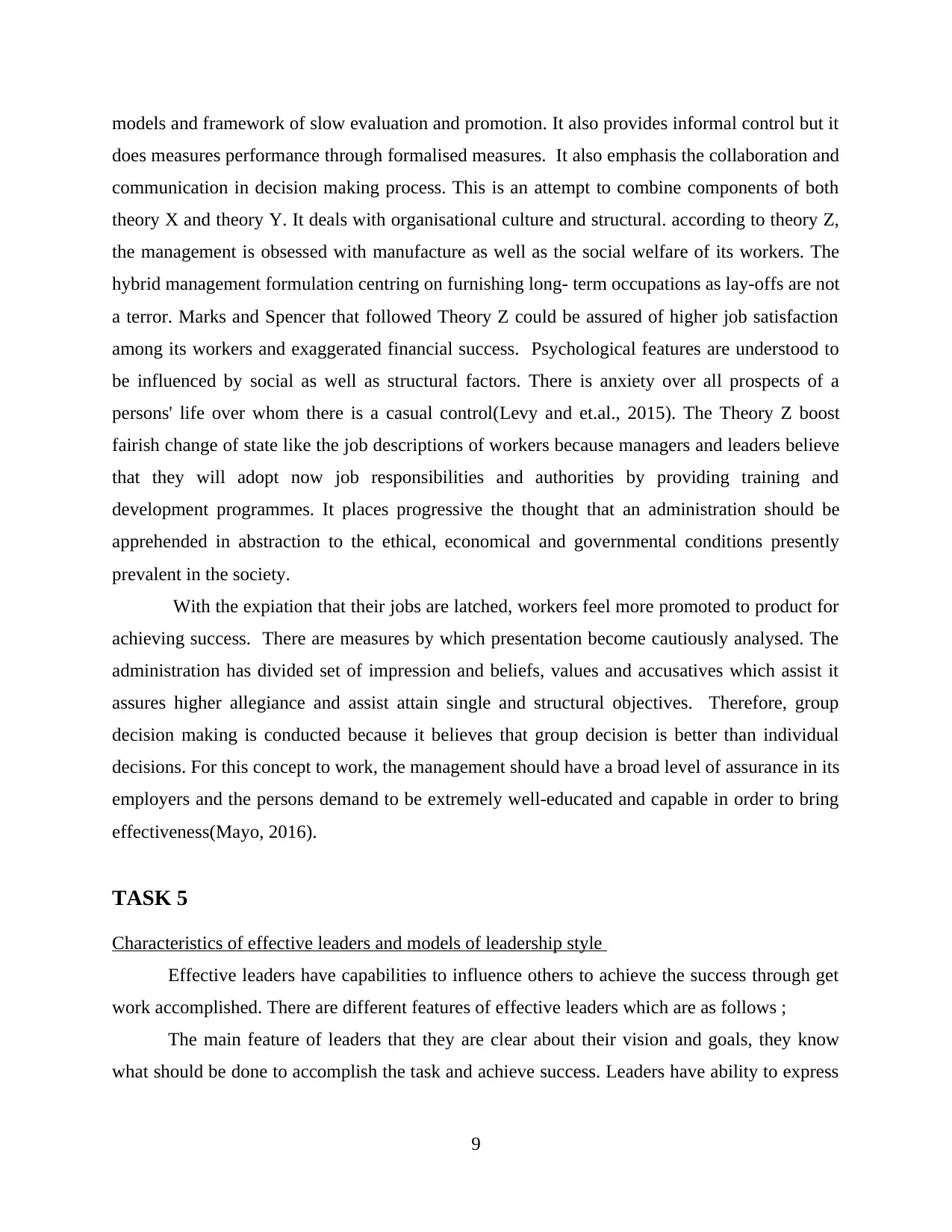
models and framework of slow evaluation and promotion. It also provides informal control but it
does measures performance through formalised measures. It also emphasis the collaboration and
communication in decision making process. This is an attempt to combine components of both
theory X and theory Y. It deals with organisational culture and structural. according to theory Z,
the management is obsessed with manufacture as well as the social welfare of its workers. The
hybrid management formulation centring on furnishing long- term occupations as lay-offs are not
a terror. Marks and Spencer that followed Theory Z could be assured of higher job satisfaction
among its workers and exaggerated financial success. Psychological features are understood to
be influenced by social as well as structural factors. There is anxiety over all prospects of a
persons' life over whom there is a casual control(Levy and et.al., 2015). The Theory Z boost
fairish change of state like the job descriptions of workers because managers and leaders believe
that they will adopt now job responsibilities and authorities by providing training and
development programmes. It places progressive the thought that an administration should be
apprehended in abstraction to the ethical, economical and governmental conditions presently
prevalent in the society.
With the expiation that their jobs are latched, workers feel more promoted to product for
achieving success. There are measures by which presentation become cautiously analysed. The
administration has divided set of impression and beliefs, values and accusatives which assist it
assures higher allegiance and assist attain single and structural objectives. Therefore, group
decision making is conducted because it believes that group decision is better than individual
decisions. For this concept to work, the management should have a broad level of assurance in its
employers and the persons demand to be extremely well-educated and capable in order to bring
effectiveness(Mayo, 2016).
TASK 5
Characteristics of effective leaders and models of leadership style
Effective leaders have capabilities to influence others to achieve the success through get
work accomplished. There are different features of effective leaders which are as follows ;
The main feature of leaders that they are clear about their vision and goals, they know
what should be done to accomplish the task and achieve success. Leaders have ability to express
9
does measures performance through formalised measures. It also emphasis the collaboration and
communication in decision making process. This is an attempt to combine components of both
theory X and theory Y. It deals with organisational culture and structural. according to theory Z,
the management is obsessed with manufacture as well as the social welfare of its workers. The
hybrid management formulation centring on furnishing long- term occupations as lay-offs are not
a terror. Marks and Spencer that followed Theory Z could be assured of higher job satisfaction
among its workers and exaggerated financial success. Psychological features are understood to
be influenced by social as well as structural factors. There is anxiety over all prospects of a
persons' life over whom there is a casual control(Levy and et.al., 2015). The Theory Z boost
fairish change of state like the job descriptions of workers because managers and leaders believe
that they will adopt now job responsibilities and authorities by providing training and
development programmes. It places progressive the thought that an administration should be
apprehended in abstraction to the ethical, economical and governmental conditions presently
prevalent in the society.
With the expiation that their jobs are latched, workers feel more promoted to product for
achieving success. There are measures by which presentation become cautiously analysed. The
administration has divided set of impression and beliefs, values and accusatives which assist it
assures higher allegiance and assist attain single and structural objectives. Therefore, group
decision making is conducted because it believes that group decision is better than individual
decisions. For this concept to work, the management should have a broad level of assurance in its
employers and the persons demand to be extremely well-educated and capable in order to bring
effectiveness(Mayo, 2016).
TASK 5
Characteristics of effective leaders and models of leadership style
Effective leaders have capabilities to influence others to achieve the success through get
work accomplished. There are different features of effective leaders which are as follows ;
The main feature of leaders that they are clear about their vision and goals, they know
what should be done to accomplish the task and achieve success. Leaders have ability to express
9
⊘ This is a preview!⊘
Do you want full access?
Subscribe today to unlock all pages.

Trusted by 1+ million students worldwide
1 out of 17
Related Documents
Your All-in-One AI-Powered Toolkit for Academic Success.
+13062052269
info@desklib.com
Available 24*7 on WhatsApp / Email
![[object Object]](/_next/static/media/star-bottom.7253800d.svg)
Unlock your academic potential
Copyright © 2020–2025 A2Z Services. All Rights Reserved. Developed and managed by ZUCOL.





